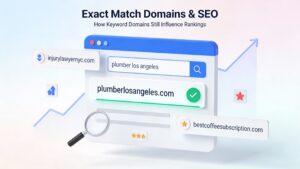Table of Contents
ToggleAffordable SEO That Actually Works: Lean Strategies Without Superstitions
There’s no shortage of talk about “affordable SEO.” The problem is, most of it’s either too cheap to be credible or too bloated to be efficient. The truth? You don’t need massive retainers, full-time content farms, or mystical “ranking hacks.” You need focused, measurable, and fast-moving SEO — the kind that trims waste, applies data, and executes what actually gets indexed and converts.
At Primary Position, we call it Lean SEO — the high-output cousin of traditional SEO that replaces superstition with precision.
1. The Problem with Traditional SEO Packages
The legacy SEO model hasn’t aged well. Too many agencies sell audits that get forgotten, content plans that never launch, and reports filled with vanity metrics no one acts on.
The pattern is predictable:
-
The client pays for a multi-phase plan.
-
Agencies spend three months “collecting data.”
-
By the time implementation happens, Google has already updated its SERP layout.
It’s SEO as bureaucracy.
Businesses don’t need 80-page audits — they need actionable checkpoints that move visibility, speed, and conversions in real time. Lean SEO exists because traditional SEO treats process as progress. The lean approach treats results as the only deliverable.
2. Lean SEO: The 3-Month Execution Framework
To make SEO affordable, you have to make it measurable and fast. That means cutting the weight and compressing the timeline. A lean SEO plan runs in three iterative stages:
Month 1: Diagnose and Deploy
-
Run a technical mini-audit targeting only crawlability, core vitals, and link structure.
-
Fix what breaks discoverability — not every “warning” in an SEO tool.
-
Implement immediate wins: title tags, schema fixes, 404 cleanup.
Month 2: Optimize What Already Exists
-
Expand indexing depth by reworking top 20% of content that drives 80% of clicks.
-
Identify intent mismatches using Google Search Console data.
-
Consolidate redundant content; slash anything that doesn’t rank or convert.
Month 3: Publish and Push
-
Build two to four new pages mapping to high-volume long-tails or local topics.
-
Streamline internal linking across pages with demonstrated ranking potential.
-
Ensure pages load sub-2.5 seconds and track uplift in conversions — not impressions.
By the end of 90 days, a lean campaign has shipped tangible improvements across rankings, CTR, and engagement — not just presentations.
3. The “Superstitions” That Kill SEO Budgets
SEO still suffers from myths that drain resources and slow execution. Here are the most expensive ones:
-
Myth 1: More blog posts mean more traffic.
Publishing weekly with no intent strategy just generates crawl waste. Ten optimized, interlinked posts beat fifty unfocused ones. -
Myth 2: Backlinks are everything.
Authority matters, but link context matters more. The days of directory stuffing or blog comment links are gone. Lean SEO focuses on semantic link relevance, not vanity counts. -
Myth 3: EEAT can be “optimized.”
Experience, Expertise, Authority, and Trust are outputs — not inputs. You don’t “add” EEAT; you demonstrate it through credible authorship, verifiable contact data, and content consistency. -
Myth 4: SEO is unpredictable.
It’s not magic. Crawlability, intent alignment, and page experience explain 80% of movement. The rest is iteration, not luck.
Affordable SEO works by killing superstition and investing only in tactics that directly support how Google’s model evaluates trust and utility.
4. Smart Spend: Where Lean SEO Puts Your Budget
The biggest mistake in “cheap SEO” is trying to cover everything at once. Lean SEO works by layering progress over time — not overspending on what users or crawlers don’t notice.
Here’s how real affordable SEO budgets break down:
-
Technical performance (20%) – Fix load times, render depth, and avoid crawl loop errors.
-
Content optimization (40%) – Refresh titles, headers, and structure for semantic intent.
-
Local SEO (20%) – Manage Google Business Profiles, reviews, and consistency.
-
Link reputation (20%) – Target backlinks from relevant, topic-matched domains.
The trick is that every dollar goes toward output — changes visible to crawlers and users within weeks.
5. SEO Speed: The New Competitive Edge
Fast SEO isn’t cowboy SEO — it’s about responsiveness. In a world where updates roll out monthly and AI-generated SERPs rewrite snippets overnight, being adaptable is everything.
Lean SEO embraces speed through:
-
Template-driven implementation: Pre-built metadata frameworks deployed sitewide.
-
Auto-crawling dashboards: Continuous crawl monitoring instead of quarterly audits.
-
AI-assisted content tuning: Testing 1-sentence optimizations before rewriting full articles.
When you remove guesswork, SEO speed increases — not the risk. The faster you test, the faster you find ROI.
6. Affordable ≠ Cheap
Affordable SEO doesn’t chase the lowest quote; it cuts nonessential output.
“Cheap SEO” promises top rankings in 30 days, spams your site with backlinks, and tanks your domain authority in six months. “Affordable SEO,” by contrast, builds a predictable pipeline of technical and content improvements over time.
A lean campaign prioritizes 20% of actions that create 80% of growth — and documents each step transparently. Clients shouldn’t have to believe in SEO anymore; they should see it working.
7. How Primary Position Redefines “Affordable” SEO
At Primary Position, we use lean methodology developed from hundreds of audits across startups, agencies, and ecommerce brands. Our model isn’t built around scope creep — it’s built around clarity:
-
No long-term contracts. Test outcomes before committing.
-
Weekly action logs. Every deliverable tied to crawl impact or ranking data.
-
Transparent reporting. You see what we fixed, what moved, and what’s next.
Our clients don’t wait six months for movement. They see performance lift in as little as 45 days — often without adding a single new page to the site.
8. Cutting the Fluff, Keeping the Results
The irony of “SEO waste” is that most wasted effort looks like productivity. Tools filled with red errors, endless competitor “gap” reports, 1,000 keyword targets — all motion, no momentum.
Lean SEO flips that.
Instead of trying to do everything Google cares about, we systematically find what Google rewards right now — and repeat it.
It’s not automation. It’s focus.
The Takeaway
Affordable SEO isn’t about shortcuts. It’s about precision, iteration, and ruthless prioritization.
When you strip away process padding, deliver smaller feedback loops, and execute faster than updates roll out, SEO becomes affordable by design — not by discount.
The agencies that still treat SEO like folklore will keep selling superstition. The ones that treat it like a performance system will keep winning — and spending less to do it.





